BY WHITNEY WEBB
LAST YEAR, A GOVERNMENT COMMISSION CALLED FOR THE US TO ADOPT AN AI-DRIVEN MASS SURVEILLANCE SYSTEM FAR BEYOND THAT USED IN ANY OTHER COUNTRY IN ORDER TO ENSURE AMERICAN HEGEMONY IN ARTIFICIAL INTELLIGENCE. NOW, MANY OF THE “OBSTACLES” THEY HAD CITED AS PREVENTING ITS IMPLEMENTATION ARE RAPIDLY BEING REMOVED UNDER THE GUISE OF COMBATING THE CORONAVIRUS CRISIS.
Last year, a U.S. government body dedicated to examining how artificial intelligence can “address the national security and defense needs of the United States” discussed in detail the “structural” changes that the American economy and society must undergo in order to ensure a technological advantage over China, according to a recent document acquired through a FOIA request. This document suggests that the U.S. follow China’s lead and even surpass them in many aspects related to AI-driven technologies, particularly their use of mass surveillance. This perspective clearly clashes with the public rhetoric of prominent U.S. government officials and politicians on China, who have labeled the Chinese government’s technology investments and export of its surveillance systems and other technologies as a major “threat” to Americans’ “way of life.”
In addition, many of the steps for the implementation of such a program in the U.S., as laid out in this newly available document, are currently being promoted and implemented as part of the government’s response to the current coronavirus (Covid-19) crisis. This likely due to the fact that many members of this same body have considerable overlap with the taskforces and advisors currently guiding the government’s plans to “re-open the economy” and efforts to use technology to respond to the current crisis.
The FOIA document, obtained by the Electronic Privacy Information Center (EPIC), was produced by a little-known U.S. government organization called the National Security Commission on Artificial Intelligence (NSCAI). It was created by the 2018 National Defense Authorization Act (NDAA) and its official purpose is “to consider the methods and means necessary to advance the development of artificial intelligence (AI), machine learning, and associated technologies to comprehensively address the national security and defense needs of the United States.”
The NSCAI is a key part of the government’s response to what is often referred to as the coming “fourth industrial revolution,” which has been described as “a revolution characterized by discontinuous technological development in areas like artificial intelligence (AI), big data, fifth-generation telecommunications networking (5G), nanotechnology and biotechnology, robotics, the Internet of Things (IoT), and quantum computing.”
However, their main focus is ensuring that “the United States … maintain a technological advantage in artificial intelligence, machine learning, and other associated technologies related to national security and defense.” The vice-chair of NSCAI, Robert Work – former Deputy Secretary of Defense and senior fellow at the hawkish Center for a New American Security (CNAS), described the commission’s purpose as determining “how the U.S. national security apparatus should approach artificial intelligence, including a focus on how the government can work with industry to compete with China’s ‘civil-military fusion’ concept.”
The recently released NSCAI document is a May 2019 presentation entitled “Chinese Tech Landscape Overview.” Throughout the presentation, the NSCAI promotes the overhaul of the U.S. economy and way of life as necessary for allowing the U.S. to ensure it holds a considerable technological advantage over China, as losing this advantage is currently deemed a major “national security” issue by the U.S. national security apparatus. This concern about maintaining a technological advantage can be seen in several other U.S. military documents and think tank reports, several of which have warned that the U.S.’ technological advantage is quickly eroding.
The U.S. government and establishment media outlets often blame alleged Chinese espionage or the Chinese government’s more explicit partnerships with private technology companies in support of their claim that the U.S. is losing this advantage over China. For instance, Chris Darby, the current CEO of the CIA’s In-Q-Tel, who is also on the NSCAI, told CBS News last year that China is the U.S.’ main competitor in terms of technology and that U.S. privacy laws were hampering the U.S.’ capacity to counter China in this regard, stating that:
“[D]ata is the new oil. And China is just awash with data. And they don’t have the same restraints that we do around collecting it and using it, because of the privacy difference between our countries. This notion that they have the largest labeled data set in the world is going to be a huge strength for them.”
In another example, Michael Dempsey – former acting Director of National Intelligence and currently a government-funded fellow at the Council on Foreign Relations – argued in The Hill that:
“It’s quite clear, though, that China is determined to erase our technological advantage, and is committing hundreds of billions of dollars to this effort. In particular, China is determined to be a world leader in such areas as artificial intelligence, high performance computing, and synthetic biology. These are the industries that will shape life on the planet and the military balance of power for the next several decades.”
In fact, the national security apparatus of the United States is so concerned about losing a technological edge over China that the Pentagon recently decided to join forces directly with the U.S. intelligence community in order “to get in front of Chinese advances in artificial intelligence.” This union resulted in the creation of the Joint Artificial Intelligence Center (JAIC), which ties together “the military’s efforts with those of the Intelligence Community, allowing them to combine efforts in a breakneck push to move government’s AI initiatives forward.” It also coordinates with other government agencies, industry, academics, and U.S. allies. Robert Work, who subsequently became the NSCAI vice-chair, said at the time that JAIC’s creation was a “welcome first step in response to Chinese, and to a lesser extent, Russian, plans to dominate these technologies.”
Similar concerns about “losing” technological advantage to China have also been voiced by the NSCAI chairman, Eric Schmidt, the former head of Alphabet – Google’s parent company, who argued in February in the New York Times that Silicon Valley could soon lose “the technology wars” to China if the U.S. government doesn’t take action. Thus, the three main groups represented within the NSCAI – the intelligence community, the Pentagon and Silicon Valley – all view China’s advancements in AI as a major national security threat (and in Silicon Valley’s case, threat to their bottom lines and market shares) that must be tackled quickly.
TARGETING CHINA’S “ADOPTION ADVANTAGE”
In the May 2019 “Chinese Tech Landscape Overview” presentation, the NSCAI discusses that, while the U.S. still leads in the “creation” stage of AI and related technologies, it lags behind China in the “adoption” stage due to “structural factors.” It says that “creation”, followed by “adoption” and “iteration” are the three phases of the “life cycle of new tech” and asserts that failing to dominate in the “adoption” stage will allow China to “leapfrog” the U.S. and dominate AI for the foreseeable future.
The presentation also argues that, in order to “leapfrog” competitors in emerging markets, what is needed is not “individual brilliance” but instead specific “structural conditions that exist within certain markets.” It cites several case studies where China is considered to be “leapfrogging” the U.S. due to major differences in these “structural factors.” Thus, the insinuation of the document (though not directly stated) is that the U.S. must alter the “structural factors” that are currently responsible for its lagging behind China in the “adoption” phase of AI-driven technologies.
Chief among the troublesome “structural factors” highlighted in this presentation are so-called “legacy systems” that are common in the U.S. but much less so in China. The NSCAI document states that examples of “legacy systems” include a financial system that still utilizes cash and card payments, individual car ownership and even receiving medical attention from a human doctor. It states that, while these “legacy systems” in the US are “good enough,” too many “good enough” systems “hinder the adoption of new things,” specifically AI-driven systems.
Another structural factor deemed by the NSCAI to be an obstacle to the U.S.’ ability to maintain a technological advantage over China is the “scale of the consumer market,” arguing that “extreme urban density = on-demand service adoption.” In other words, extreme urbanization results in more people using online or mobile-based “on-demand” services, ranging from ride-sharing to online shopping. It also cites the use of mass surveillance on China’s “huge population base” is an example of how China’s “scale of consumer market” advantage allowing “China to leap ahead” in the fields of related technologies, like facial recognition.
In addition to the alleged shortcomings of the U.S.’ “legacy systems” and lack of “extreme urban density,” the NSCAI also calls for more “explicit government support and involvement” as a means to speed up the adoption of these systems in the U.S. This includes the government lending its stores of data on civilians to train AI, specifically citing facial recognition databases, and mandating that cities be “re-architected around AVs [autonomous vehicles],” among others. Other examples given include the government investing large amounts of money in AI start-ups and adding tech behemoths to a national, public-private AI taskforce focused on smart city-implementation (among other things).
With regards to the latter, the document says “this level of public-private cooperation” in China is “outwardly embraced” by the parties involved, with this “serving as a stark contrast to the controversy around Silicon Valley selling to the U.S. government.” Examples of such controversy, from the NSCAI’s perspective, likely include Google employees petitioning to end the Google-Pentagon “Project Maven,” which uses Google’s AI software to analyze footage captured by drones. Google eventually chose not to renew its Maven contract as a result of the controversy, even though top Google executives viewed the project as a “golden opportunity” to collaborate more closely with the military and intelligence communities.
The document also defines another aspect of government support as the “clearing of regulatory barriers.” This term is used in the document specifically with respect to U.S. privacy laws, despite the fact that the U.S. national security state has long violated these laws with near complete impunity. However, the document seems to suggest that privacy laws in the U.S. should be altered so that what the U.S. government has done “in secret” with private citizen data can be done more openly and more extensively. The NSCAI document also discusses the removal of “regulatory barriers” in order to speed up the adoption of self-driving cars, even though autonomous driving technology has resulted in several deadly and horrific car accidents and presents other safety concerns.
Also discussed is how China’s “adoption advantage” will “allow it to leapfrog the U.S.” in several new fields, including “AI medical diagnosis” and “smart cities.” It then asserts that “the future will be decided at the intersection of private enterprise and policy leaders between China and the U.S.” If this coordination over the global AI market does not occur, the document warns that “we [the U.S.] risk being left out of the discussions where norms around AI are set for the rest of our lifetimes.”
The presentation also dwells considerably on how “the main battleground [in technology] are not the domestic Chinese and US markets,” but what it refers to as the NBU (next billion users) markets, where it states that “Chinese players will aggressively challenge Silicon Valley.” In order to challenge them more successfully, the presentation argues that, “just like we [view] the market of teenagers as a harbinger for new trends, we should look at China.”
The document also expresses concerns about China exporting AI more extensively and intensively than the U.S., saying that China is “already crossing borders” by helping to build facial databases in Zimbabwe and selling image recognition and smart city systems to Malaysia. If allowed to become “the unambiguous leader in AI,” it says that “China could end up writing much of the rulebook of international norms around the deployment of AI” and that it would “broaden China’s sphere of influence amongst an international community that increasingly looks to the pragmatic authoritarianism of China and Singapore as an alternative to Western liberal democracy.”
WHAT WILL REPLACE THE US’ “LEGACY SYSTEMS”?
Given that the document makes it quite clear that “legacy systems” in the U.S. are impeding its ability to prevent China from “leapfrogging” ahead in AI and then dominating it for the foreseeable future, it is also important to examine what the document suggests should replace these “legacy systems” in the U.S.
As previously mentioned, one “legacy system” cited early on in the presentation is the main means of payment for most Americans, cash and credit/debit cards. The presentation asserts, in contrast to these “legacy systems” that the best and most advanced system is moving entirely to smartphone-based digital wallets.
It notes specifically the main mobile wallet provider in India, PayTM, is majority owned by Chinese companies. It quotes an article, which states that “a big break came [in 2016] when India canceled 86% of currency in circulation in an effort to cut corruption and bring more people into the tax net by forcing them to use less cash.” At the time, claims that India’s 2016 “currency reform” would be used as a stepping stone towards a cashless society were dismissed by some as “conspiracy theory.” However, last year, a committee convened by India’s central bank (and led by an Indian tech oligarch who also created India’s massive civilian biometric database) resulted in the Indian government’s “Cashless India” program.
Regarding India’s 2016 “currency reform,” the NSCAI document then asserts that “this would be unfathomable in the West. And unsurprisingly, when 86% of the cash got cancelled and nobody had a credit card, mobile wallets in India exploded, laying the groundwork for a far more advanced payments ecosystem in India than the US.” However, it has become increasingly less unfathomable in light of the current coronavirus crisis, which has seen efforts to reduce the amount of cash used because paper bills may carry the virus as well as efforts to introduce a Federal Reserve-backed “digital dollar.”
In addition, the NSCAI document from last May calls for the end of in-person shopping and promotes moving towards all shopping being performed online. It argues that “American companies have a lot to gain by adopting ideas from Chinese companies” by shifting towards exclusive e-commerce purchasing options. It states that only shopping online provides a “great experience” and also adds that “when buying online is literally the only way to get what you want, consumers go online.”
Another “legacy system” that the NSCAI seeks to overhaul is car ownership, as it promotes autonomous, or self-driving vehicles and further asserts that “fleet ownership > individual ownership.” It specifically points to a need for “a centralized ride-sharing network,” which it says “is needed to coordinate cars to achieve near 100% utilization rates.” However, it warns against ride-sharing networks that “need a human operator paired with each vehicle” and also asserts that “fleet ownership makes more sense” than individual car ownership. It also specifically calls for these fleets to not only be composed of self-driving cars, but electric cars and cites reports that China “has the world’s most aggressive electric vehicle goals….and seek[s] the lead in an emerging industry.”
The document states that China leads in ride-sharing today even though ride-sharing was pioneered first in the U.S. It asserts once again that the U.S. “legacy system” of individual car ownership and lack of “extreme urban density” are responsible for China’s dominance in this area. It also predicts that China will “achieve mass autonomous [vehicle] adoption before the U.S.,” largely because “the lack of mass car ownership [in China] leads to far more consumer receptiveness to AVs [autonomous vehicles].” It then notes that “earlier mass adoption leads to a virtuous cycle that allows Chinese core self-driving tech to accelerate beyond [its] Western counterparts.”
In addition to their vision for a future financial system and future self-driving transport system, the NSCAI has a similarly dystopian vision for surveillance. The document calls mass surveillance “one of the ‘first-and-best customers’ for AI” and “a killer application for deep learning.” It also states that “having streets carpeted with cameras is good infrastructure.”
It then discusses how “an entire generation of AI unicorn” companies are “collecting the bulk of their early revenue from government security contracts” and praises the use of AI in facilitating policing activities. For instance, it lauds reports that “police are making convictions based on phone calls monitored with iFlyTek’s voice-recognition technology” and that “police departments are using [AI] facial recognition tech to assist in everything from catching traffic law violators to resolving murder cases.”
On the point of facial recognition technology specifically, the NSCAI document asserts that China has “leapt ahead” of the US on facial recognition, even though “breakthroughs in using machine learning for image recognition initially occurred in the US.” It claims that China’s advantage in this instance is because they have government-implemented mass surveillance (“clearing of regulatory barriers”), enormous government-provided stores of data (“explicit government support”) combined with private sector databases on a huge population base (“scale of consumer market”). As a consequence of this, the NSCAI argues, China is also set to leap ahead of the U.S. in both image/facial recognition and biometrics.
The document also points to another glaring difference between the U.S. and its rival, stating that: “In the press and politics of America and Europe, Al is painted as something to be feared that is eroding privacy and stealing jobs. Conversely, China views it as both a tool for solving major macroeconomic challenges in order to sustain their economic miracle, and an opportunity to take technological leadership on the global stage.”
The NSCAI document also touches on the area of healthcare, calling for the implementation of a system that seems to be becoming reality thanks to the current coronavirus crisis. In discussing the use of AI in healthcare (almost a year before the current crisis began), it states that “China could lead the world in this sector” and “this could lead to them exporting their tech and setting international norms.” One reason for this is also that China has “far too few doctors for the population” and calls having enough doctors for in-person visits a “legacy system.” It also cited U.S. regulatory measures such as “HIPPA compliance and FDA approval” as obstacles that don’t constrain Chinese authorities.
More troubling, it argues that “the potential impact of government supplied data is even more significant in biology and healthcare,” and says it is likely that “the Chinese government [will] require every single citizen to have their DNA sequenced and stored in government databases, something nearly impossible to imagine in places as privacy conscious as the U.S. and Europe.” It continues by saying that “the Chinese apparatus is well-equipped to take advantage” and calls these civilian DNA databases a “logical next step.”
WHO ARE THE NSCAI?
Given the sweeping changes to the U.S. that the NSCAI promoted in this presentation last May, it becomes important to examine who makes up the commission and to consider their influence over U.S. policy on these matters, particularly during the current crisis. As previously mentioned, the chairman of the NSCAI is Eric Schmidt, the former head of Alphabet (Google’s parent company) who has also invested heavily in Israeli intelligence-linked tech companies including the controversial start-up “incubator” Team8. In addition, the committee’s vice-chair is Robert Work, is not only a former top Pentagon official, but is currently working with the think tank CNAS, which is run by John McCain’s long-time foreign policy adviser and Joe Biden’s former national security adviser.
Other members of the NSCAI are as follows:
- Safra Catz, CEO of Oracle, with close ties to Trump’s top donor Sheldon Adelson
- Steve Chien, supervisor of the Artificial Intelligence Group at Caltech’s Jet Propulsion Lab
- Mignon Clyburn, Open Society Foundation fellow and former FCC commissioner
- Chris Darby, CEO of In-Q-Tel (CIA’s venture capital arm)
- Ken Ford, CEO of the Florida Institute for Human and Machine Cognition
- Jose-Marie Griffiths, president of Dakota State University and former National Science Board member
- Eric Horvitz, director of Microsoft Research Labs
- Andy Jassy, CEO of Amazon Web Services (CIA contractor)
- Gilman Louie, partner at Alsop Louie Partners and former CEO of In-Q-Tel
- William Mark, director of SRI International and former Lockheed Martin director
- Jason Matheny, director of the Center for Security and Emerging Technology, former Assistant director of National Intelligence and former director of IARPA (Intelligence Advanced Research Project Agency)
- Katharina McFarland, consultant at Cypress International and former Assistant Secretary of Defense for Acquisition
- Andrew Moore, head of Google Cloud AI
As can be seen in the list above, there is a considerable amount of overlap between the NSCAI and the companies currently advising the White House on “re-opening” the economy (Microsoft, Amazon, Google, Lockheed Martin, Oracle) and one NSCAI member, Oracle’s Safra Katz, is on the White House’s “economic revival” taskforce. Also, there is also overlap between the NSCAI and the companies that are intimately involved in the implementation of the “contact tracing” “coronavirus surveillance system,” a mass surveillance system promoted by the Jared Kushner-led, private-sector coronavirus task force. That surveillance system is set to be constructed by companies with deep ties to Google and the U.S. national security state, and both Google and Apple, who create the operating systems for the vast majority of smartphones used in the U.S., have said they will now build that surveillance system directly into their smartphone operating systems.
Also notable is the fact that In-Q-Tel and the U.S. intelligence community has considerable representation on the NSCAI and that they also boast close ties with Google, Palantir and other Silicon Valley giants, having been early investors in those companies. Both Google and Palantir, as well as Amazon (also on the NSCAI) are also major contractors for U.S. intelligence agencies. In-Q-Tel’s involvement on the NSCAI is also significant because they have been heavily promoting mass surveillance of consumer electronic devices for use in pandemics for the past several years. Much of that push has come from In-Q-Tel’s current Executive Vice President Tara O’Toole, who was previously the director of the Johns Hopkins Center for Health Security and also co-authored several controversial biowarfare/pandemic simulations, such as Dark Winter.
In addition, since at least January, the U.S. intelligence community and the Pentagon have been at the forefront of developing the U.S. government’s still-classified “9/11-style” response plans for the coronavirus crisis, alongside the National Security Council. Few news organizations have noted that these classified response plans, which are set to be triggered if and when the U.S. reaches a certain number of coronavirus cases, has been created largely by elements of the national security state (i.e. the NSC, Pentagon, and intelligence), as opposed to civilian agencies or those focused on public health issues.
Furthermore, it has been reported that the U.S. intelligence community as well as U.S. military intelligence knew by at least January (though recent reports have said as early as last November) that the coronavirus crisis would reach “pandemic proportions” by March. The American public were not warned, but elite members of the business and political classes were apparently informed, given the record numbers of CEO resignations in January and several high-profile insider trading allegations that preceded the current crisis by a matter of weeks.
Perhaps even more disconcerting is the added fact that the U.S. government not only participated in the eerily prescient pandemic simulation last October known as Event 201, it also led a series of pandemic response simulations last year. Crimson Contagion was a series of four simulations that involved 19 U.S. federal agencies, including intelligence and the military, as well as 12 different states and a host of private sector companies that simulated a devastating pandemic influenza outbreak that had originated in China. It was led by the current HHS Assistant Secretary for Preparedness and Response, Robert Kadlec, who is a former lobbyist for military and intelligence contractors and a Bush-era homeland security “bioterrorism” advisor.
In addition, both Kadlec and the Johns Hopkins Center for Health Security, which was intimately involved in Event 201, have direct ties to the controversial June 2001 biowarfare exercise “Dark Winter,” which predicted the 2001 anthrax attacks that transpired just months later in disturbing ways. Though efforts by media and government were made to blame the anthrax attacks on a foreign source, the anthrax was later found to have originated at a U.S. bioweapons lab and the FBI investigation into the case has been widely regarded as a cover-up, including by the FBI’s once-lead investigator on that case.
Given the above, it is worth asking if those who share the NSCAI’s vision saw the coronavirus pandemic early on as an opportunity to make the “structural changes” it had deemed essential to countering China’s lead in the mass adoption of AI-driven technologies, especially considering that many of the changes in the May 2019 document are now quickly taking place under the guise of combatting the coronavirus crisis.
THE NSCAI’S VISION TAKES SHAPE
Though the May 2019 NSCAI document was authored nearly a year ago, the coronavirus crisis has resulted in the implementation of many of the changes and the removal of many of the “structural” obstacles that the commission argued needed to be drastically altered in order to ensure a technological advantage over China in the field of AI. The aforementioned move away from cash, which is taking place not just in the U.S. but internationally, is just one example of many.
For instance, earlier this week CNN reported that grocery stores are now considering banning in-person shopping and that the U.S. Department of Labor has recommended that retailers nationwide start “‘using a drive-through window or offering curbside pick-up’ to protect workers for exposure to coronavirus.” In addition, last week, the state of Florida approved an online-purchase plan for low income families using the Supplemental Nutrition Assistance Program (SNAP). Other reports have argued that social distancing inside grocery stores is ineffective and endangering people’s lives. As previously mentioned, the May 2019 NSCAI document argues that moving away from in-person shopping is necessary to mitigate China’s “adoption advantage” and also argued that “when buying online is literally the only way to get what you want, consumers go online.”
Reports have also argued that these changes in shopping will last far beyond coronavirus, such as an article by Business Insider entitled “The coronavirus pandemic is pushing more people online and will forever change how Americans shop for groceries, experts say.” Those cited in the piece argue that this shift away from in-person shopping will be “permanent” and also states that “More people are trying these services than otherwise would have without this catalyst and gives online players a greater chance to acquire and keep a new customer base.” A similar article in Yahoo! News argues that, thanks to the current crisis, “our dependence on online shopping will only rise because no one wants to catch a virus at a shop.”
In addition, the push towards the mass use of self-driving cars has also gotten a boost thanks to coronavirus, with driverless cars now making on-demand deliveries in California. Two companies, one Chinese-owned and the other backed by Japan’s SoftBank, have since been approved to have their self-driving cars used on California roads and that approval was expedited due to the coronavirus crisis. The CPO of Nuro Inc., the SoftBank-backed company, was quoted in Bloomberg as saying that “The Covid-19 pandemic has expedited the public need for contactless delivery services. Our R2 fleet is custom-designed to change the very nature of driving and the movement of goods by allowing people to remain safely at home while their groceries, medicines, and packages are brought to them.” Notably, the May 2019 NSCAI document references the inter-connected web of SoftBank-backed companies, particularly those backed by its largely Saudi-funded “Vision Fund,” as forming “the connective tissue for a global federation of tech companies” set to dominate AI.
California isn’t the only state to start using self-driving cars, as the Mayo Clinic of Florida is now also using them. “Using artificial intelligence enables us to protect staff from exposure to this contagious virus by using cutting-edge autonomous vehicle technology and frees up staff time that can be dedicated to direct treatment and care for patients,” Kent Thielen, M.D., CEO of Mayo Clinic in Florida stated in a recent press release cited by Mic.
Like the changes to in-person shopping in the age of coronavirus, other reports assert that self-driving vehicles are here to stay. One report published by Mashable is entitled “It took a coronavirus outbreak for self-driving cars to become more appealing,” and opens by stating “Suddenly, a future full of self-driving cars isn’t just a sci-fi pipe dream. What used to be considered a scary, uncertain technology for many Americans looks more like an effective tool to protect ourselves from a fast-spreading, infectious disease.” It further argues that this is hardly a “fleeting shift” in driving habits and one tech CEO cited in the piece, Anuja Sonalker of Steer Tech, claims that “There has been a distinct warming up to human-less, contactless technology. Humans are biohazards, machines are not.”
Another focus of the NSCAI presentation, AI medicine, has also seen its star rise in recent weeks. For instance, several reports have touted how AI-driven drug discovery platforms have been able to identify potential treatments for coronavirus. Microsoft, whose research lab director is on the NSCAI, recently put $20 million into its “AI for health” program to speed up the use of AI in analyzing coronavirus data. In addition, “telemedicine”– a form of remote medical care – has also become widely adopted due to the coronavirus crisis.
Several other AI-driven technologies have similarly become more widely adopted thanks to coronavirus, including the use of mass surveillance for “contact tracing” as well as facial recognition technology and biometrics. A recent Wall Street Journal report stated that the government is seriously considering both contact tracing via phone geolocation data and facial recognition technology in order to track those who might have coronavirus. In addition, private businesses – like grocery stores and restaurants – are using sensors and facial recognition to see how many people and which people are entering their stores.
As far as biometrics go, university researchers are now working to determine if “smartphones and biometric wearables already contain the data we need to know if we have become infected with the novel coronavirus.” Those efforts seek to detect coronavirus infections early by analyzing “sleep schedules, oxygen levels, activity levels and heart rate” based on smartphone apps like FitBit and smartwatches. In countries outside the U.S., biometric IDs are being touted as a way to track those who have and lack immunity to coronavirus.
In addition, one report in The Edge argued that the current crisis is changing what types of biometrics should be used, asserting that a shift towards thermal scanning and facial recognition is necessary:
“At this critical juncture of the crisis, any integrated facial recognition and thermal scanning solution must be implemented easily, rapidly and in a cost-effective manner. Workers returning to offices or factories must not have to scramble to learn a new process or fumble with declaration forms. They must feel safe and healthy for them to work productively. They just have to look at the camera and smile. Cameras and thermal scanners, supported by a cloud-based solution and the appropriate software protocols, will do the rest.”
Also benefiting from the coronavirus crisis is the concept of “smart cities,” with Forbes recently writing that “Smart cities can help us combat the coronavirus pandemic.” That article states that “Governments and local authorities are using smart city technology, sensors and data to trace the contacts of people infected with the coronavirus. At the same time, smart cities are also helping in efforts to determine whether social distancing rules are being followed.”
That article in Forbes also contains the following passage:
“…[T]he use of masses of connected sensors makes it clear that the coronavirus pandemic is–intentionally or not–being used as a testbed for new surveillance technologies that may threaten privacy and civil liberties. So aside from being a global health crisis, the coronavirus has effectively become an experiment in how to monitor and control people at scale.”
Another report in The Guardian states that “If one of the government takeaways from coronavirus is that ‘smart cities’ including Songdo or Shenzhen are safer cities from a public health perspective, then we can expect greater efforts to digitally capture and record our behaviour in urban areas – and fiercer debates over the power such surveillance hands to corporations and states.” There have also been reports that assert that typical cities are “woefully unprepared” to face pandemics compared to “smart cities.”
Yet, beyond many of the NSCAI’s specific concerns regarding mass AI adoption being conveniently resolved by the current crisis, there has also been a concerted effort to change the public’s perception of AI in general. As previously mentioned, the NSCAI had pointed out last year that:
“In the press and politics of America and Europe, Al is painted as something to be feared that is eroding privacy and stealing jobs. Conversely, China views it as both a tool for solving major macroeconomic challenges in order to sustain their economic miracle, and an opportunity to take technological leadership on the global stage.”
Now, less than a year later, the coronavirus crisis has helped spawn a slew of headlines in just the last few weeks that paint AI very differently, including “How Artificial Intelligence Can Help Fight Coronavirus,” “How AI May Prevent the Next Coronavirus Outbreak,” “AI Becomes an Ally in the Fight Against COVID-19,” “Coronavirus: AI steps up in battle against COVID-19,” and “Here’s How AI Can Help Africa Fight the Coronavirus,” among numerous others.
It is indeed striking how the coronavirus crisis has seemingly fulfilled the NSCAI’s entire wishlist and removed many of the obstacles to the mass adoption of AI technologies in the United States. Like major crises of the past, the national security state appears to be using the chaos and fear to promote and implement initiatives that would be normally rejected by Americans and, if history is any indicator, these new changes will remain long after the coronavirus crisis fades from the news cycle. It is essential that these so-called “solutions” be recognized for what they are and that we consider what type of world they will end up creating – an authoritarian technocracy. We ignore the rapid advance of these NSCAI-promoted initiatives and the phasing out of so-called “legacy systems” (and with them, many long-cherished freedoms) at our own peril.
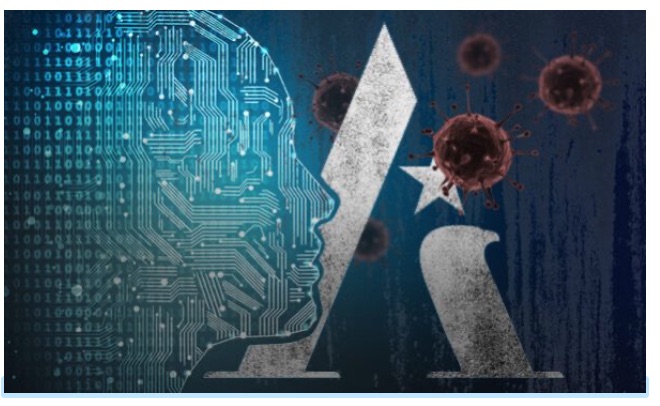





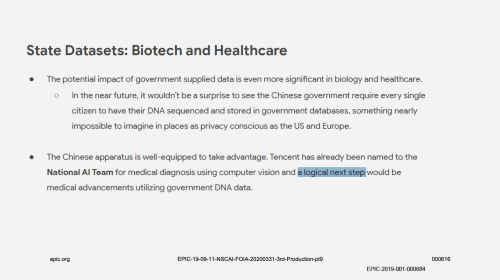



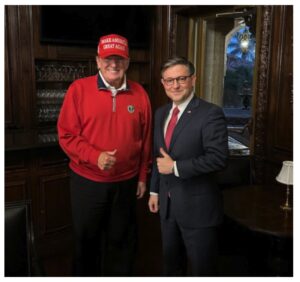



What gets me is it seems the “test” is often not applied, they just go by the symptoms like high temperature. A high temperature is the body’s way of killing a germ. You might just have a normal cold or flu or or normal coronavirus and are labelled CV19 when you are not at all. Then you can’t go out or work or go shopping. The government has no right to quarantine the whole society. They are taking away our human rights. This is a psyop like 9/11. Media brainwashing.
Someone….anyone…tell me this is not a take-down of this country. IF YOU THINK NOT, YOU HAVE YOUR HEAD IN A DARK, DARK PLACE!
This is un-friggin believable!!
DESTROYING FOOD BEING PRODUCED IN THIS COUNTRY!
https://153news.net/watch_video.php?v=733S95SH67OS
Yes, anything perishable that can’t be trucked right away to market due to normal orders or picked in the fields, etc. is destroyed because they have to get ready to reseed the fields. The markets, schools, restaurants are not ordering as usual. Its a mess due to this stupid lockdown.
People were screaming that the meat and produce should at least be sent to food banks. But someone has to truck it there.
I do not know the real inside scoop on the Chinese owned pork plants but I suspect some foul play.
I like goats milk, hope it can be there when I shop….so far they have it.
I just took this scn/print, ten minutes ago on 4/28/2020. 4:PM EST About 75 people were in this White House room.
I noticed only 2 persons with a mask on in this Press Report by the President.
No one was doing Social-Distancing.
It was as if there was no pandemic. Everything was normal.
It was full of cameras….reporters….WH cooks and caterers.
Attachment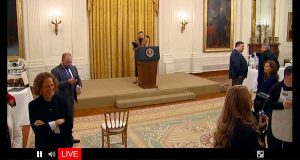
Same time as my scn grab above today in WH….I see only one mask….a cameraman out of 14 in this shot. I do see no-mask seating is distancing but they mingled closely afterwards without distance, ate food that was provided and acted normally until the LIVE feed was cut.. Total hypocrisy.
Attachment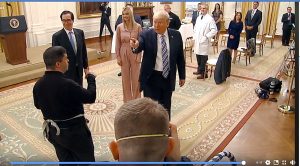
Dr Fetzer
Here in MN i am hearing a lot of repetition in using the phrase “Moonshot”- from health commissioners, from governor, and others.
https://kttc.com/2020/04/28/pence-to-visit-mayo-clinic-to-learn-about-testing-moonshot/
(from Tim Walz’ twitter Apr 22:) “I asked for a Minnesota moonshot and our healthcare partners delivered. This testing breakthrough will be transformative to our COVID-19 response, allowing us to better protect Minnesotans and build a more clear picture of how COVID-19 is impacting us.”
I remember hearing Biden use this strange term in referring to the “Cancer Moonshot” a few years ago- which struck me as VERY odd at the time- so much so that I have not forgotten it.
From a language standpoint, I wonder if you share this sentiment…
a) the general populous may be somewhat confused by the ongoing use this strange and obtuse term
b) the use of this term is a GIVEAWAY that this is fraudulent and is nothing more than a media/screen driven reality being cast upon the masses- much as it was in the Apollo days.
just my observation- thanks
REALLY great report from Rappoport:
A message about suicide to the pod people wearing masks
https://blog.nomorefakenews.com/
This is a new interview from Dr. Buttar. There’s info here I have never heard. You may have to provide your email to watch. I am not sure.
As a caveat, I came across LondonReal and was impressed and decided to contribute a small amount to their efforts. Even before I finished filling out the form (seriously!), I received an email welcoming me and thanking me for a $100 contribution. So far, the charge has not appeared on my credit card……so I just present this as a warning if you decide to contribute…be careful.
Anyway, no contribution is necessary to watch. This is fairly mind-boggling information!
I will also add they have thrown interference on my computer and I had to re-boot to get the “static” off. I should mention this has happened several times lately…including on the Raw Deal this past Sunday.They definitely seem to be monitoring my activity in real time.
Here’s the video:
https://tinyurl.com/yb297rra
I wish to add, as I am still watching this vid, it will be by far, the most important vid you have watched in regard to this hoax. Buttar use the term, 5G and it is NOT CENSORED on this independent media source.
Also, if anyone here has the ability to post this on 153news.net, please do so.
Here’s the video he mentions called Toxicology Ignored…apparently the only vid in his series that has not been censored.
https://www.youtube.com/watch?v=-idDrRqUKTk
A friend sent me a YT version where you do not have to sign up. The 5G part may be censored….have not watched, so I do not know…but it’s the same vid as the previous one without having to sign up.
https://www.youtube.com/watch?v=L7cnCGs-4tI
This one is for Billau….
https://153news.net/watch_video.php?v=MNNY12SK35AB
US will continue distancing until the end of summer? Are you shitting me? Live normally. Do not fall for this mass insanity!!
https://www.zerohedge.com/geopolitical/new-zealand-prepares-lift-lockdown-dr-birx-says-us-will-continue-social-distancing
Jon Rappoport
Protests nationwide scheduled for May 1
(To read about Jon’s mega-collection, The Matrix Revealed, click here.)
NOTE TO READERS: If you are an email subscriber and are seeing this article as an email, you’ll notice the links are not live. This is because including live links multiplies the chance of poor delivery and bounces. You can read this article, with live links, at my blog, via NoMoreFakeNews.
A growing number of groups in US states are preparing protests against the lockdowns on May 1.
I’ve found two sites that are publishing information on the protests.
americanrevolution2[dot]org
openthestates[dot]com
Check out your state and see what’s upcoming.
As far as I can tell, this is not a top-down single-leader movement. It’s a state by state proposition. That would be a good thing. Groups in each state should run their own operations.
Here is a quote from americanrevolution2[dot]org:
“Governor Executive Orders violate the United States Constitution and negate the responsibility of individual citizens for their ‘Life, Liberty, and Pursuit of Happiness’. The precedent set by removing these Constitutional Rights is staggering and to date unheard of.”
Of course, agencies like the CDC and the World Health Organization appoint themselves the “new global governance.” Their job is painting as bleak a picture as possible, making it seem that, without their top-down control, the population of Earth would be decimated.
This is always the way of tyrants. How else can they justify their criminal actions?
The endless invention of enemies is a strategy as old as the hills.
Peace and prosperity are stakes through the hearts of vampires.
For the CDC and WHO and Bill Gates, the idea that someone somewhere might be living free and healthy on his own accord…THAT to them is the virus which must be conquered.
To accomplish this victory, they enlist the help of public and private meddlers and gossipers and snitches and censors, whose only thrill in life is finding “rule-breakers.” Therefore, the more rules the better.
The culture of society is becoming more infantile every day—wash your hands, wash them again, don’t touch your face, stay indoors, wear a mask, wear gloves, stand six feet apart, wait in line, don’t breathe on your neighbor, be polite, watch TV for marching orders—but those people who still understand what freedom means are under no obligation to cater to that “culture.”
Lowest common denominator is not a principle contained in the Constitution. In fact, wherever the principle is found, it’s a cover for dictatorship. For example, the ubiquitous “we’re all in this together” is a massage for the brainless.
Translation: “You’re all one giant cheese glob, and we, the World Health Organization, with Bill Gates money, are pressing the two pieces of toast together and making the sandwich.”
State by state, the protests against unconstitutional insanity are scheduled for May 1.
OPEN THE STATES. GO BACK TO WORK. TURN ON THE ECONOMY.
The first Holocaust Remembrance Day and the WHO’s Declaration of the Coronavirus Global Health Emergency
Haaretz : The first Holocaust Remembrance Day
https://www.haaretz.com/the-history-of-holocaust-remembrance-day-1.5246317
The first Holocaust Remembrance Day took place on December 28th, 1949, a year-and-a-half after Israel’s independence.
*
Guardian : WHO declares coronavirus a global health emergency
https://www.theguardian.com/world/2020/jan/30/who-declares-coronavirus-a-global-health-emergency
Wikipedia : On 30 January, the WHO declared the outbreak to be a Public Health Emergency of International Concern.[258]
https://en.wikipedia.org/wiki/2019%E2%80%9320_coronavirus_pandemic
*
From The first Holocaust Remembrance Day on December 28, 1949
to the WHO Declaration of the coronavirus global health emergency on January 30, 2020
= 666 months, 666 weeks, 666 days
https://www.timeanddate.com/date/dateadded.html?d1=28&m1=12&y1=1949&type=add&ay=&am=666&aw=666&ad=666&rec=
MG
From Jim Stone….
“Home Despot??!!?”
Home Depot put in new “coronavirus” measures that have people irked. One person in, one person out. Very bad service as employees stand behind plexiglass. 100 percent full time obvious in your face cameras recording every move. Lines that snake around the store for checkout, and around the outside of the store to get in. This is all over social media now – and people are beginning to call the place “home despot”. That might fit, because:
Home Depot and Lowes (which are associated with the elite at the top) are both putting such measures in place, but the last of the classics – Menards, is not. And people have noticed – MENARDS IS PACKED. And what does that mean? It means that there are no laws telling either Home Depot or Lowes to become despotic, it is pure choice and enforcing an agenda. Menards will likely come out the winner.
ME….Stone has it right this time….I can definitely attest to this happening at my Home Depot in Lake City, Fl….
They are letting in ONE CUSTOMER at a time. the others wait obediently outside with masks on at least 10 feet apart.
They sure as hell lost me as a customer. So far, it is not happening at Lowes.
Since I was humoring Brian with anti-social distancing, I waited in my car for his walk up customer to finish and leave. I decided on the fly to drop in to the gun store two doors down. The Proprieter backed up like he was about to be robbed. Wish I had video of it. I asked where were all the guns? There was none in cases and none on the walls. There were no pictures of guns on the empty wallscape. He never answered a really simple question, where are the guns? Then Gun Store Guy asked if I could back up. I’m like “really?”… (thought bubble)… ‘you’re falling for this shit too?’… I asked him how long the wait was for a gun purchase approval?… asking him that somehow disarmed the barbs on his back. He looked at his computer and said 7 days and change.Then Gun Guy said he had no idea where I had just been… like he could die just talking to me. As if I was typhoid Mary incarnate and had just returned from an orgie with Haitian Hemophiliac Heroine Addicts sharing their last needle and some rapid bat soup. I don’t think anyone will recover mentally from the Planned-Demic Paranoia virus.
I told Gun Store Guy I could leave now and never come back and walked out. I’ve never been so eager to check out a store’s wears and felt such paraonia and hostility thwarting me from doing so. From the Proprietor ! With no criminal record I should be instantly approved for a rifle or shotgun. That should take a phone call to one source the CBI and any state policeman with a computer or wait for it… a working telephone! . No criminal record should mean instant approval. And that does not happen. How about not seeing any guns displayed in a gun store? The World has gone insane.
As I exited the no gun gun store in disgust, I walked up to buy a six pack at the plywood fortress that once was a liquor store. The scared shitless gun store guy came outside and from 40 feet away started yelling his paranoid justifications for brooming me out of his store. He asked if I noticed the boarded up liquor store in front of me? Oh you mean the one I’m doing business with right now or some other one?
I wondered why the gun guy was even open? if anyone needs a self quarantine, it’s him.
These experiences prove the Planned-Demic is a master stroke of psychological warfare, the success of which is a wet dream for our Globalist Enslavers. They don’t even need an actual new plague, just fear inducement by every network and newspaper and a lockstep march off a financial cliff by the willing and the duped.
Has anyone heard a former executive from Vodophone and his take on Corona Scam? He says it’s 5G that’s the real killer and the virus is the cover story. So many stories out there, I try to listen to sources not obviously connected with Gov’t or big media.
One thing that’s really ringing true is this. People are going to hospitals far and wide and not finding any activity associated with being overwhelmed. Why is that? My take is they have to keep the cover story going on the out break panic until 5G is fully implimented. Then they won’t have to fake the massive carnage anymore. The laws that are being passed take away all freedom as we know it. People are just going along and chastising those that ignore stay at home orders. It’s hard to explain the total lay down to this Planned-Demic Economic 911.
dK…Is this a test….? It’s a great story, but if i counted correctly, this is the third or so posting.
If it’s a game, I’m biting.
10 minutes presentation on 5G radiation as the root cause. Interesting experiments were done in Boston during the 1918 flu outbreak on the transmissibility and found it wasn’t at all. They even injected mucous into healthy people failed to infect them. It was right around then that radio signals were broadcast for the first time. There was another massive flu outbreak right after radar fields became a thing. Worth checking out. Even the 5G executives admit there was never any safety tests conducted during Senate hearings. The very first place to get 5G blanket coverage was Wuhan. https://www.youtube.com/watch?v=nW-sCKqpJx4…
dK..I appreciate the reply…. but I don’t get the connection. I was questioning why you have posted the gun shop story several times. Maybe you did not and I saw the previous postings in a parallel universe or I dreamed it. Beats the hell outta me.
In any case, I have no doubt this hoax is a cover for several things….an economic reset, covert 5G installations, a psychological operation to gather information for the next false flag…on and on and on. The idea that the term 5G was censored from that interview with Buttar (is that his name?) and it’s subsequent removal from the Next News Network is a dead give-away.
I told the gun store story before. It’s hard to remember what parts of my personal scam-demic experience I told and did not tell. My latest inquiry has to do with this huge disconnect between what I can see with my own eyes and what I read from places like the Boston Globe’s 21 pages of obituaries. I wanted to really dig into these stories to see how many were attributed to Covid19 that were like my friend Rod who had the COPD, cancer and diabetes and was 65. They said in the obituary he lost his battle with Covid 19. My personal opinion is he died of the 40 years of rock star lifestyle. I wonder how many there are like this. By the way someone just posted the pictures of Denver’s new Tent City skid row that is very much like an LA slum starter kit. This is accelerating fast
Attachment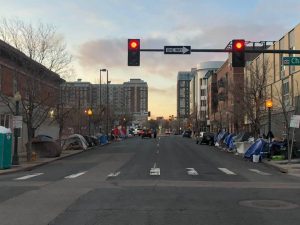
Thanks, dK…I appreciative the clarification.
Let’s face it….and I am far from the first to state this….the world has gone mad…stark raving mad.
And now, as you will see from a vid from Shiva that I just posted, even those who looked like they are working toward a common goal …..truth and NO VACCINES…..are now fighting each other…..just insane. Can the peasants and those supposedly working with us, at least put their differences aside and work together by exposing these bastardz instead of fighting each other? It’s sickening and ignorant.
From the mouth of the “DON” himself!
https://153news.net/watch_video.php?v=US54A92O31A8
Dear Friends:
I don’t even know if I could read another story about how fucked we are. Some how I missed this Gates interview on April 3rd. This Bill Gates interview is about the most blood boiling single event I have noticed so far. I have seen him say the same things over and over. But there’s something about this appearance that should light a fire inside every true American Patriot.
See right through Billy Boy’s smug demeanor. Try pausing it right before Bill’s answers. Watch every frame paused between the question and answer. You will see his delighted pleasure in what’s happening. His reactions to questions are far more telling then the answers. Duper’s Delight only lasts a second but it’s priceless here.
Here’s the summary. Billy Boy appointed himself supreme commander of the Planned-Demic and says nothing will go back to normal until we have 7 billion vaccines doses. Tells us he decided no sporting events until a vaccine and that’s a minimum of 18 months away. Go isolate yourself until Billy says it’s okay to have a life again. Things will never go back to normal. Billy knows what’s best for you. He said “we are all in this together”. Really Billy? Nothing could be a bigger lie than that. I don’t see Billy joining a mile long food bank line. At what point do you all wake up and opt out of the economic suicide pact everyone seems to have joined? Please please watch this and try pausing it right before Bill’s answers.
https://www.youtube.com/watch?time_continue=1832&v=NDnjXdDxEhk&feature=emb_logo
Don’t give that satanic sob your time or energy…..when and if it comes time for his mandatory vaccine, find a way to opt out….lotsa ways on the web.
Consider…..
https://www.youtube.com/watch?v=ZIELtYIsbD4
will… thanks. everyone should watch this guy, he kicks ass on declining smart meters and vaccines. A light bulb went off in my head because Bill Gates said something about skipping safety protocols on his corona vaccine and getting indemnification from the government. That’s the lynch pin of effective refusal no one knows about.
Gates = smug, smirking, self-satisfied, sociopath.
All this means is the end of privacy and freedom in the US….as if it’s not gone already. Kiss it good-bye….
Makes me wonder what they will do with dinosaurs like myself void of a cell or smart phone. Camps? I guess so.
Just gets better every day.